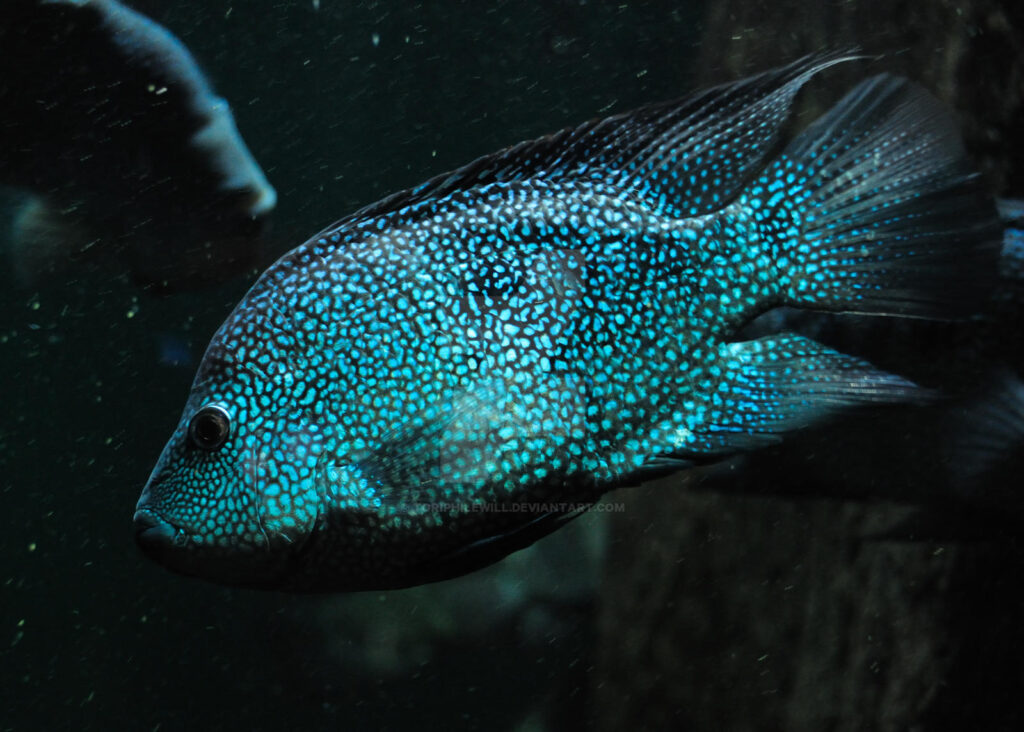Discover the ultimate Texas Cichlid care guide! Learn about their tank setup, diet, lifespan, size, and ideal tank mates. Perfect for beginner and experienced aquarists alike.
If you’ve ever wanted a fish that’s bold, beautiful, and packed with personality, the Texas Cichlid might just be your dream pet. Known for their striking blue-green scales and lively nature, these fish are among the most rewarding—yet challenging—species to keep.
In this guide, I’ll share everything I’ve learned about Texas Cichlid care, from personal experience and research, to help you set up the perfect tank, choose the right diet, and keep your fish healthy for years.
👉 Quick Answer: Texas Cichlids need a large tank (at least 55 gallons), slightly warm water, a protein-rich diet, and careful tank mate selection due to their territorial nature.
Texas Cichlid Overview
Before we dive into care details, let’s cover the basics:
-
Scientific name: Herichthys cyanoguttatus
-
Origin: Rivers of southern Texas and northern Mexico
-
Temperament: Aggressive and territorial
-
Focus Keyword: Texas Cichlid Care
These fish are the only cichlid species native to the U.S., which makes them even more fascinating to keep.
Texas Cichlid Size & Max Size
One of the first questions new aquarists ask is: How big do Texas Cichlids get?
👉 Short Answer: Texas Cichlids typically grow to 10–12 inches, with some reaching their max size of 13 inches in spacious tanks.
In my experience, their size can surprise new owners. I once underestimated how quickly mine grew, and within a year, my 55-gallon tank felt small. Lesson learned: always plan for their adult size, not just the cute juvenile you bring home.
Texas Cichlid Lifespan
👉 Short Answer: With proper care, Texas Cichlids live 10–13 years.
That’s a big commitment, especially compared to smaller freshwater fish like barbs or tetras. Their long lifespan makes them more like a family pet than just a decorative fish. I’ve met aquarists who have had their Texas Cichlids for over a decade—it’s a true long-term relationship.
Texas Cichlid Tank Setup
When it comes to Texas Cichlid tank setup, space and structure are everything.
👉 Short Answer: Provide at least 55 gallons per fish, use sand or fine gravel, and include rocks and driftwood for hiding spots.
Here’s what works best:
-
Tank Size: 55 gallons minimum, but 75+ is better.
-
Substrate: Sand or smooth gravel (they love digging).
-
Decorations: Rocks, caves, driftwood—anything that creates territories.
-
Plants: Hardy species like Java fern or Anubias (but beware, they might uproot them).
-
Filtration: A strong filter is essential to handle their waste output.
Texas Cichlid Diet
👉 Short Answer: Texas Cichlids need a varied, protein-rich diet with high-quality pellets, frozen foods, and occasional vegetables.
Here’s what I feed mine:
-
Staple Food: Hikari Cichlid Gold Pellets – high in protein and vitamins.
-
Frozen Foods: Bloodworms, brine shrimp, and krill.
-
Veggies: Peas, spinach, or zucchini as a treat.
Mixing their diet not only keeps them healthy but also brings out their vibrant colors. I noticed my cichlid’s blue-green spots became brighter once I added krill to the menu.
Texas Cichlid Tank Mates
👉 Short Answer: Choose similar-sized, semi-aggressive fish as tank mates—or keep them alone.
Best options include:
-
Other large cichlids (Oscar, Jack Dempsey, Green Terror)
-
Silver Dollars
-
Plecos
Avoid small, timid fish like guppies or tetras. They’ll become dinner.
💡 Personal Tip: I once tried adding a group of convicts as tank mates. Big mistake. Within days, my Texas Cichlid claimed half the tank and bullied the others. Since then, I only keep them with equally tough fish.
Breeding Texas Cichlids
👉 Short Answer: Texas Cichlids breed easily in captivity but become extremely aggressive when protecting their fry.
If you plan to breed them:
-
Provide flat rocks for spawning.
-
Keep tank mates to a minimum.
-
Be ready to separate parents if aggression spikes.
They can lay up to 1,000 eggs at a time, and both parents will fiercely guard their fry.
Common Health Issues
Like most cichlids, Texas Cichlids are hardy, but they’re not immune to problems.
👉 Short Answer: The most common issues are Ich, Hole-in-the-Head Disease, and Fin Rot.
Prevention is key:
-
Keep water clean with strong filtration.
-
Perform regular water changes.
-
Quarantine new fish before introducing them.
Texas Cichlid Behavior & Personality
These fish are fascinating because they’re so interactive. Mine follows me when I walk past the tank and even recognizes feeding time.
👉 Short Answer: Texas Cichlids are intelligent, territorial, and interactive—but they demand respect.
Their bold nature makes them fun to watch, but also a challenge when it comes to community tanks.
Final Thoughts on Texas Cichlid Care
Texas Cichlids are not beginner fish, but they’re one of the most rewarding species you can keep if you’re ready for the challenge. Their stunning colors, long lifespan, and lively behavior make them unforgettable.
👉 Quick Recap:
-
Tank Setup: 55+ gallons with rocks and driftwood.
-
Lifespan: 10–13 years.
-
Size: Up to 13 inches.
-
Diet: Protein-rich with pellets, frozen food, and veggies.
-
Tank Mates: Only other large, semi-aggressive fish.
If you’re ready to commit, the Texas Cichlid will reward you with years of color, personality, and interaction.

